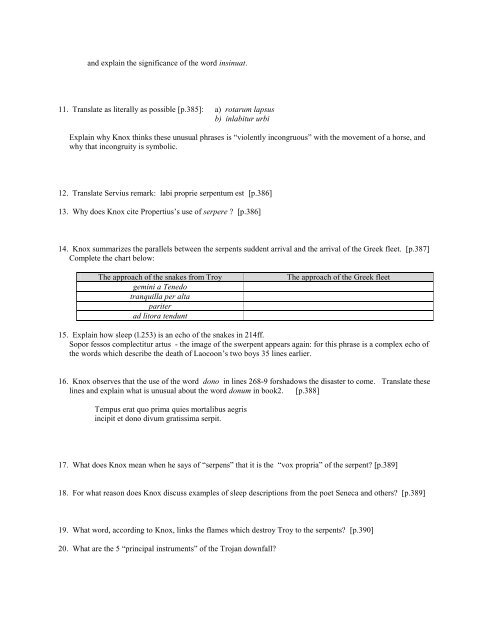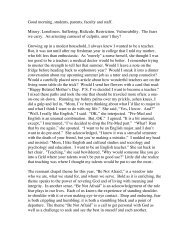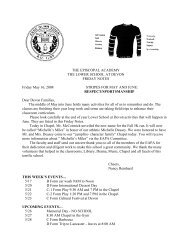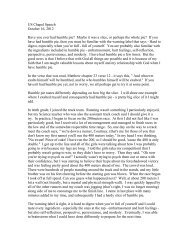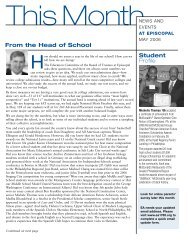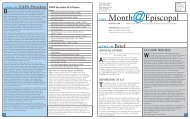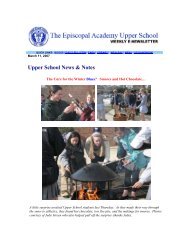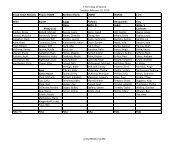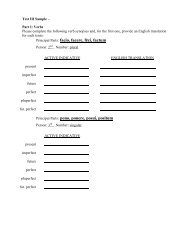Serpent&Flame TK's guidingQuestions2012.pdf - Episcopal Academy
Serpent&Flame TK's guidingQuestions2012.pdf - Episcopal Academy
Serpent&Flame TK's guidingQuestions2012.pdf - Episcopal Academy
You also want an ePaper? Increase the reach of your titles
YUMPU automatically turns print PDFs into web optimized ePapers that Google loves.
and explain the significance of the word insinuat. It echos the word sinuat which V. used just 20 linesearlier to describe the snakes approach, and which is a stock phrase to describe serpents. And while insinuare iscommon in other authors, it is a word Vergil uses only this once.11. Translate as literally as possible [p.385]: a) rotarum lapsus a gliding of wheelsb) inlabitur urbi it glides into the cityExplain why Knox thinks these unusual phrases is “violently incongruous” with the movement of a horse, andwhy that incongruity is symbolic. The description of the Trojan efforts to bring the horse into the city suggestanything but the ‘frictionless speed’ which such a phrase implies. Instead, we see the horse pulled with greateffort (accingunt operi, scandit fatalis machina muros) stumbling over the debries of the broken wall, which 4times jerks to a halt when it reaches the threashold. …not at all a smooth entry!12. Translate Servius remark: labi proprie serpentum est [p.386] to glide is the special characteristic of the serpent.13. Why does Knox cite Propertius’s use of serpere ? [p.386] Because P. was describing the same event (ie. themovement of the horse into Troy) and the fact that he too used clearly snake like imagery for the horse supportsKnox’s contention that such an unusual image wasn’t too much of a stretch for a Roman poet.14. Knox summarizes the parallels between the serpents suddent arrival and the arrival of the Greek fleet. [p.387]Complete the chart below:The approach of the snakes from Troygemini a Tenedotranquilla per altapariterad litora tenduntThe approach of the Greek fleet…a Tenedotacitae per amica silentia lunaeinstructis navibuslitora nota petens15. Explain how sleep (l.253) is an echo of the snakes in 214ff.Sopor fessos complectitur artus - the image of the swerpent appears again: for this phrase is a complex echo ofthe words which describe the death of Laocoon’s two boys 35 lines earlier.16. Knox observes that the use of the word dono in lines 268-9 forshadows the disaster to come. Translate theselines and explain what is unusual about the word donum in book2. [p.388]Tempus erat quo prima quies mortalibus aegrisincipit et dono divum gratissima serpit.It was the time when first slumber begins for weary mortalsAnd it creeps most grateful as a gift of the gods.The word donum, “gift” should have positive connotations, but in every time Vergil has used it thus far in thebook, it has referred to the horse, and has a menacing feel.17. What does Knox mean when he says of “serpens” that it is the “vox propria” of the serpent? [p.389]That the verb serpo (and its participle serpens) is an essential quality and particularly belonging to the serpent.18. For what reason does Knox discuss examples of sleep descriptions from the poet Seneca and others? [p.389]Seneca and others describe sleep with more traditional vocabulary – repere. Therefore Vergil’s unusual choiceof serpere is an intential effort to strengthen the snake metaphor.19. What word, according to Knox, links the flames which destroy Troy to the serpents? [p.390] supero20. What are the 5 “principal instruments” of the Trojan downfall?


